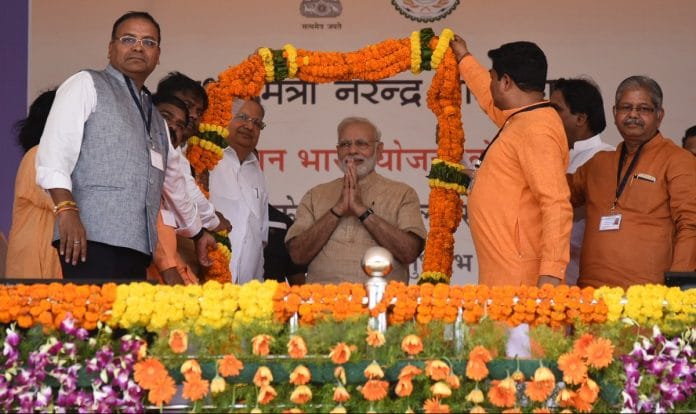PM Narendra Modi is expected to launch Ayushman Bharat, the game-changer health insurance scheme, during his Independence Day speech at Red Fort.
New Delhi: The NDA government’s ambitious healthcare scheme Ayushman Bharat draws from similar initiatives in China, Thailand and South Korea, but remains patently ‘Made in India’, says the development banker behind ‘Modicare’.
The healthcare scheme, which aims to provide a health cover of up to Rs 5 lakh each year to an estimated 10 crore vulnerable families, is expected to be launched by PM Narendra Modi during his Independence Day speech from the Red Fort Wednesday.
Once introduced, Ayushman Bharat is poised to be the largest government-funded health insurance scheme in the world.
Ayushman Bharat-National Health Protection Mission (AB-NHPM) CEO Indu Bhushan is a former director general of the east Asia department in the Philippines-based Asian Development Bank (ADB), where he helped formulate healthcare models for several countries, including Vietnam, Cambodia, Thailand, China, and Mongolia.
This experience helped Bhushan as he got to work on Ayushman Bharat, with the final result drawing from the Chinese scheme’s IT infrastructure, the fraud-prevention and detection mechanism employed by the Thais, and Korea’s use of patient-generated data to introduce artificial intelligence (AI) in healthcare.
Why China, Thailand and Korea?
China’s healthcare reforms, which began in 2009 with the aim of ensuring affordable universal basic healthcare for all citizens, have had considerable success.
Though described as very “basic” by experts, with patients of more serious diseases still sinking into poverty to fund their own treatment, state insurance cover is said to have reached almost the entire population of the country, according to WHO estimates.
“In the last decade, China has lowered its out-of-pocket expenditure from 80 per cent to 20 per cent. We have taken learning from its IT infrastructure, which is commendable,” Bhushan said, adding that his most recent assignment with the ADB was in China.
Also read: As Modicare launch nears, Modi tells team to be ready to counter negative news coverage
“They also have intelligently built health packages. But it cannot be applied in the case of India. China’s expenditure on the health sector is at least thrice India’s. Its per capita income is four times ours. There are many on-the-ground differences between both the countries,” he said.
A major focus ahead of Ayushman Bharat rollout was the prevention of fraud, a key concern that threatens to drain crucial resources set aside for the scheme. Asked by PM Modi to mitigate the scope for manipulation, Bhushan said he looked east again, to Thailand.
A 2016 report by the United Nations International Labour Office explained how a national population database shared with social organisations and smart cards helped Thailand build a secure healthcare system that also reached the maximum number of people.
“They have the best healthcare scheme in terms of a watertight fraud-proof system,” Bhushan said, but added that the obvious size and population disparity meant customising the model to India’s needs. “It (Thailand) is a small country where the extent of the scheme is limited and the application uniform,” he added.
South Korea’s experience with its health insurance review and assessment service (HIRA) will contribute to the use of breakthrough AI technologies to optimise daily operations, he said.
HIRA analyses big data to reflect the changing healthcare environment on the basis of screening results collected over years. “In the future, we also plan to use patients’ medical results data for research and development. It will transform the healthcare industry,” Bhushan added.
Even so, he insisted, the final product will be uniquely Indian. “For India, the case is not ‘been there and done that’. India needed a highly customised model considering the diversity of the country. We have developed an exclusive model for India that, in some form, has drawn lessons from the successful models across the globe,” he added.
“We have developed a model that is made for India, in keeping with its diverse population and squeezed healthcare budget. However, I have no illusion that there will be no challenges after it is launched. It may be revised on a daily basis in the initial stages,” he said.
“For starting a scheme, the funding of Rs 10,000 crore is apt. However, the scheme will require more funds in the coming times.”
Also read: Private hospitals agree to join Ayushman Bharat after Modi govt promises to revise rates
One nation, one scheme?
If the scheme proves successful, the government may explore the possibility of bringing all the state healthcare schemes under Ayushman Bharat.
“In the later stages, we should explore the opportunity of combining all the health schemes — Central Government Health Scheme (CGHS) and Employees’ State Insurance (ESI) — under one implementation agency which could be AB-NHPM,” said Bhushan.
This is a model followed by many countries, including Taiwan and Turkey. “It is a very sensible model as we can share infrastructure,” said Bhushan, “Consider this: A beneficiary under Ayushman Bharat can also get admitted to ESI or CGHS hospitals.”
Ayushman Bharat is expected to be a game-changer for India, where the World Bank estimates 62 per cent of healthcare expenses are out-of-pocket, according to a Bloomberg report.
The Economic Survey for 2016-17 pointed out as much, and noted that Indians faced higher out-of-pocket expenses on healthcare than their counterparts in the other four BRICS nations (Brazil, Russia, China and South Africa).
“The higher OoP (out-of-pocket) expenditure on health leads to impoverishment of poorer sections of society and widens inequalities. OoP expenditure for poor is a double whammy because, one, adverse health conditions impact their productivity and ability to earn their daily incomes and, second, payments to get themselves treated adds to their financial distress and impoverishes them,” it said.






